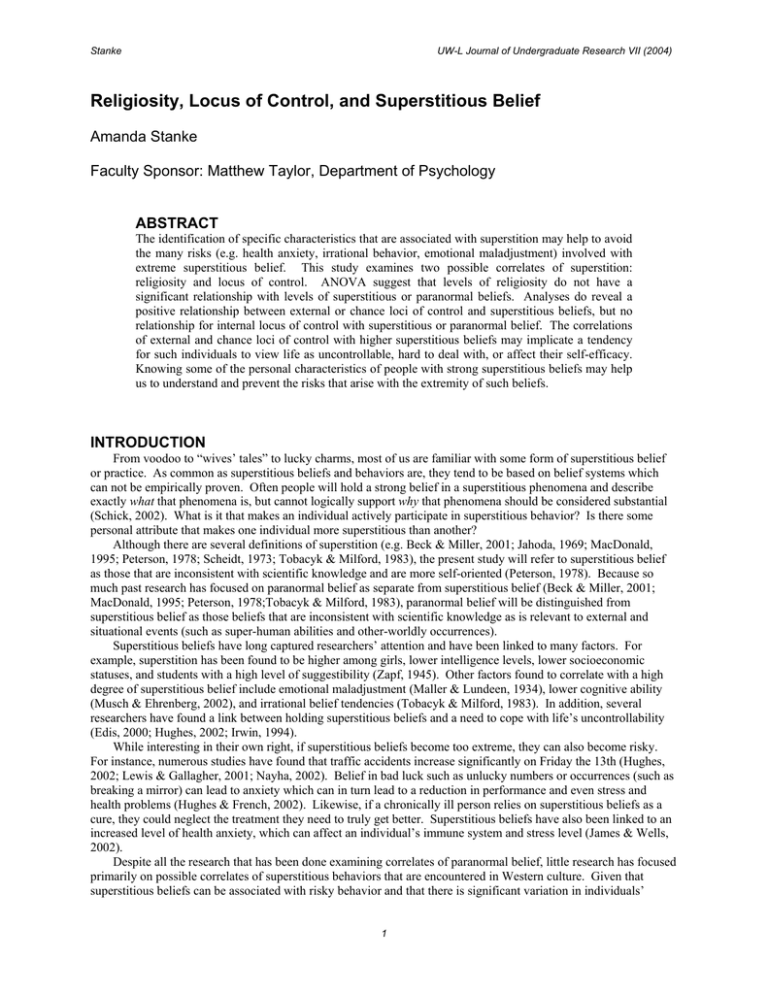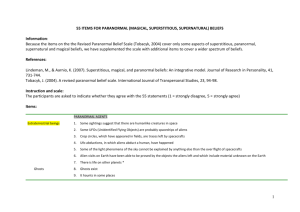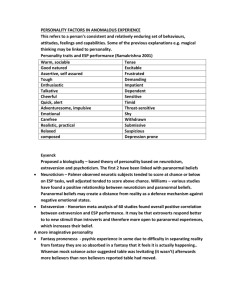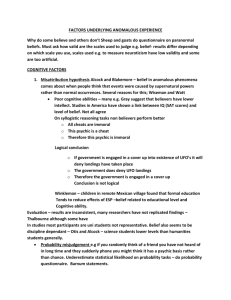Religiosity, Locus of Control, and Superstitious Belief Amanda Stanke
advertisement

Stanke UW-L Journal of Undergraduate Research VII (2004) Religiosity, Locus of Control, and Superstitious Belief Amanda Stanke Faculty Sponsor: Matthew Taylor, Department of Psychology ABSTRACT The identification of specific characteristics that are associated with superstition may help to avoid the many risks (e.g. health anxiety, irrational behavior, emotional maladjustment) involved with extreme superstitious belief. This study examines two possible correlates of superstition: religiosity and locus of control. ANOVA suggest that levels of religiosity do not have a significant relationship with levels of superstitious or paranormal beliefs. Analyses do reveal a positive relationship between external or chance loci of control and superstitious beliefs, but no relationship for internal locus of control with superstitious or paranormal belief. The correlations of external and chance loci of control with higher superstitious beliefs may implicate a tendency for such individuals to view life as uncontrollable, hard to deal with, or affect their self-efficacy. Knowing some of the personal characteristics of people with strong superstitious beliefs may help us to understand and prevent the risks that arise with the extremity of such beliefs. INTRODUCTION From voodoo to “wives’ tales” to lucky charms, most of us are familiar with some form of superstitious belief or practice. As common as superstitious beliefs and behaviors are, they tend to be based on belief systems which can not be empirically proven. Often people will hold a strong belief in a superstitious phenomena and describe exactly what that phenomena is, but cannot logically support why that phenomena should be considered substantial (Schick, 2002). What is it that makes an individual actively participate in superstitious behavior? Is there some personal attribute that makes one individual more superstitious than another? Although there are several definitions of superstition (e.g. Beck & Miller, 2001; Jahoda, 1969; MacDonald, 1995; Peterson, 1978; Scheidt, 1973; Tobacyk & Milford, 1983), the present study will refer to superstitious belief as those that are inconsistent with scientific knowledge and are more self-oriented (Peterson, 1978). Because so much past research has focused on paranormal belief as separate from superstitious belief (Beck & Miller, 2001; MacDonald, 1995; Peterson, 1978;Tobacyk & Milford, 1983), paranormal belief will be distinguished from superstitious belief as those beliefs that are inconsistent with scientific knowledge as is relevant to external and situational events (such as super-human abilities and other-worldly occurrences). Superstitious beliefs have long captured researchers’ attention and have been linked to many factors. For example, superstition has been found to be higher among girls, lower intelligence levels, lower socioeconomic statuses, and students with a high level of suggestibility (Zapf, 1945). Other factors found to correlate with a high degree of superstitious belief include emotional maladjustment (Maller & Lundeen, 1934), lower cognitive ability (Musch & Ehrenberg, 2002), and irrational belief tendencies (Tobacyk & Milford, 1983). In addition, several researchers have found a link between holding superstitious beliefs and a need to cope with life’s uncontrollability (Edis, 2000; Hughes, 2002; Irwin, 1994). While interesting in their own right, if superstitious beliefs become too extreme, they can also become risky. For instance, numerous studies have found that traffic accidents increase significantly on Friday the 13th (Hughes, 2002; Lewis & Gallagher, 2001; Nayha, 2002). Belief in bad luck such as unlucky numbers or occurrences (such as breaking a mirror) can lead to anxiety which can in turn lead to a reduction in performance and even stress and health problems (Hughes & French, 2002). Likewise, if a chronically ill person relies on superstitious beliefs as a cure, they could neglect the treatment they need to truly get better. Superstitious beliefs have also been linked to an increased level of health anxiety, which can affect an individual’s immune system and stress level (James & Wells, 2002). Despite all the research that has been done examining correlates of paranormal belief, little research has focused primarily on possible correlates of superstitious behaviors that are encountered in Western culture. Given that superstitious beliefs can be associated with risky behavior and that there is significant variation in individuals’ 1 Stanke UW-L Journal of Undergraduate Research VII (2004) beliefs, it would be helpful to understand some of the major correlates of superstitious beliefs. This study focuses on two possible correlates: religiosity and locus of control. Religious orientation tends to fit into one of three categories - “fundamental, moderate, or liberal” (MacDonald, 1995). Similarly, religiosity refers to the frequency of religious practices and the strength of the religious beliefs behind them. The current research will examine religiosity and refer to it as the strength or extent of the individual’s religious beliefs and practices. Religiosity has been found to correlate with the occurrence of superstitious and paranormal beliefs in many studies (Beck & Miller, 2001; MacDonald, 1995; Orenstein, 2002; Tobacyk & Milford, 1983). MacDonald (1995) found that a higher degree of religiosity correlated with a higher frequency of reporting belief in paranormal experiences such as telepathy, but not belief in experiences such as clairvoyance. Beck and Miller (2001) found a correlation between a high degree of religiosity and higher levels of belief in the supernatural. They also found that participants high in religiosity who had also encountered an emotionally negative experience in the past year decreased in their degree of supernatural belief. Their study suggests that there is a correlation between religiosity and superstitious belief when combined with life experiences. Orenstein (2002) did not find a correlation between greater religious participation and paranormal belief. This study did find, however, that greater religious belief independent of religious participation correlated with a high degree of paranormal belief. Similar to extreme superstitious beliefs, external locus of control has been described as an individual’s attributing life events to luck, fate, or external forces (Scheidt, 1973). Locus of control refers to the extent to which an individual attributes personal life events to external factors or other people (external) or to their own disposition (internal). Indeed, an external locus of control has been found to correlate with belief in paranormal, supernatural, and superstitious phenomena in many studies (Belter & Brinkmann, 1981; Irwin, 1994; Groth-Marnat & Pegden, 1998; Peterson, 1978; Randall & Desrosiers, 1980; Scheidt, 1973). Irwin (1994) suggests that paranormal belief is the result of those with an external locus of control attempting to deal with the perceived uncontrollability of their lives. The present study will investigate the relationship between superstitious or paranormal beliefs, religiosity, and locus of control. In particular, the question of whether an individual’s degree of religiosity and locus of control will affect the extremity of that individual’s superstitious beliefs and behaviors will be examined. Three predictions are made: 1. An individual’s degree of religiosity will be positively related to that individual’s level of superstitious belief. 2. Those individuals with an external locus of control will hold a higher degree of belief in superstition. 3. Those individuals with an internal locus of control will hold a lower degree of belief in superstition. METHOD Participants 189 undergraduate students at a mid-sized university in the Midwest were included as participants for this research. They were predominantly female (69.3%), Caucasian (96.8%), Christian (82.7%), and had a mean age of 20.67 (SD = 3.49). Materials and Procedure An anonymous pencil and paper questionnaire was administered to participants containing four separate scales for the measurement of each of the following variables: superstitious beliefs, paranormal beliefs, religiosity, and locus of control. Students acknowledged their informed consent by completing the questionnaire. Locus of control was measured using Levenson’s (1981) Internality, Powerful Others, and Chance Scales containing 24 items in the form of statements which participants can rate their agreement/disagreement. Religiosity was measured using Scott’s (1965) short version of the Religiousness subscale of the Personal Value Scales, which contains five statements regarding religious practices. Superstitious belief was measured using the Superstitiousness Questionnaire (Zebb & Moore, 2003), containing 18 self-report items reflecting typical superstitious beliefs of Western cultures. Paranormal belief was measured using the Paranormal Short Inventory (Randall, 1997), which contains 13 statements about paranormal beliefs. Each item on the questionnaire was rated by the individual on a Likert-type scale ranging from one to six, with one being “strongly disagree” and six being “strongly agree.” 2 Stanke UW-L Journal of Undergraduate Research VII (2004) Data Analysis and Dissemination Primary analyses were done with ANOVA. The dependent variables were superstitious belief and paranormal belief. The independent variables were degree of religiosity (strong, moderate, or weak) and locus of control (external, chance, or internal). Correlations were also performed. RESULTS No relationship was found between degree of religiosity and level of superstitious or paranormal belief (MHigh 16.09, SD = 5.23; MLow religiosity = 17.62, SD = 7.20), F(2, 186) = 1.28, p = .281. However, a significant relationship was found in comparing external locus of control with high superstitious beliefs (MHigh external locus of control = 25.08, SD = 4.72; MLow external locus of control = 22.76, SD = 5.86), F(2, 184) = 3.140, p = .046. Conversely, no significant relationship was found among internal locus of control and superstitious beliefs (MHigh internal locus of control = 35.86, SD = 3.70; MLow internal locus of control = 35.81, SD = 5.41), F(2, 186) = .004, p = ns. Upon examination of religiosity in comparison with locus of control, high religiosity was found to be negatively correlated with an internal locus of control, r(189) = -.17, p =.02. Comparisons of chance locus of control with paranormal and superstitious beliefs also revealed a significant relationship (MHigh chance locus of control = 24.78, SD = 4.58; MLow chance locus of control = 21.27, SD = 5.86). Those with a chance locus of control showed higher paranormal beliefs, r(186) = .19, p = .01, as well as higher superstitious beliefs, r(186) = .28, p = .0001, F (2,185) = 8.767, p = .000. A significant relationship was also found among those who scored high on both paranormal and superstitious beliefs, r(185) = .56, p = .0001. In addition to these findings, a significant difference was found among genders and paranormal belief with females scoring higher than males on such beliefs (MFemale paranormal beliefs = 35.66, SD = 8.98; MMale paranormal beliefs = 32.00, SD = 10.32), F(1,186) = 5.963, p = .016. religiosity = DISCUSSION The prediction that high degrees of religiosity would correlate with strong superstitious belief and that low degrees of religiosity would correlate with weak superstitious belief was not supported. This does not support most of the previous research done in this area, which dominantly found a relationship between high religiosity and strong superstitious and paranormal beliefs (Beck & Miller, 2001; MacDonald, 1995; Orenstein, 2002; Tobacyk & Milford, 1983). The results in this study may be interpreted to support the findings of Orenstein (2002), in which high religiosity did correlate with strong paranormal belief, but only when religious belief was held independent of religious participation. Although there may be a link between religiosity and superstitious belief, the connection may not be as simple as this study attempted to make it to be. Previous research has often looked at the relationship between more specific personality characteristics in addition to religiosity as they relate to superstitious beliefs. For example, social acceptance (Jahoda, 1969), a sense of balance in life (Edis, 2000), a sense of comfort (Hughes, 2002), or a need to cope with feelings of uncontrollability (Irwin,1994), are a few the personal motivations found to correlate with belief in superstition. However, examining personal characteristics in addition to religiosity as they relate to superstitious belief may have been a potential weakness in previous research. Perhaps by eliminating the examination of such personal characteristics other than religiosity, we are better able to see the direct relationship (or lack thereof) between religiosity and superstitious belief. Alternatively, this study may have been too leading for subjects, allowing them to clearly distinguish between “religious belief” items and “superstitious belief” items, in effect revealing stronger than normal differences between the responses to these items. Future studies might continue to exclude personal characteristic items, but disguise the superstitious and religiosity items in such a way that participants will not be inclined to answer in a biased manner. Other advantages to future research in this area may be to more thoroughly distinguish between beliefs and behaviors. For instance, while many participants in the present study indicated a religious background or belief (e.g. Catholic, Presbyterian), the same participants reflected a low degree of religiosity in their scores. These occurrences may suggest that in modern Western culture, while many individuals do hold a particular religious faith, they may not necessarily be active participants. Likewise, while many may hold superstitious beliefs, the seriousness they hold those beliefs with may not carry over into actual practice. For example, while many people may believe that breaking a mirror will bring seven years of bad luck, once they actually break a mirror, they might not necessarily 3 Stanke UW-L Journal of Undergraduate Research VII (2004) consider themselves doomed for the next seven years. Perhaps future studies in this area should distinguish between religious belief and religious practice as well as between superstitious belief and superstitious practice, in order to find more conclusive correlations. Results did, however, reveal that individuals with an external locus of control held a higher degree of belief in superstition. Participants with an external locus of control were more likely to hold strong superstitious beliefs, although this correlation was not found with paranormal beliefs. This finding supports previous research in which an external locus of control was found to correlate with strong superstitious and paranormal belief (Belter & Brinkmann, 1981; Irwin, 1994; Groth-Marnat & Pegden, 1998; Peterson, 1978; Randall & Desrosiers, 1980; Scheidt, 1973). Interestingly, in measuring a third form of locus of control, chance, a significant relationship was found with both strong superstitious and strong paranormal beliefs. The discovery of a correlation between both chance and external locus of control with strong superstitious beliefs supports the theory proposed by previous research that there may be a link between holding superstitious beliefs and the feelings of a need to cope with the uncontrollability of life (Edis, 2000; Hughes, 2002; Irwin, 1994). If individuals with strong superstitious beliefs do find a need to cope with life’s uncontrollability, it is possible that these individuals also have problems with selfconcept. Future research might examine such personal characteristics as self-esteem, self-efficacy, or a tendency for depression in individuals that hold strong superstitious beliefs. Identifying the need in these people for using superstitious beliefs to deal with their feelings of lack of control may assist in the therapeutic process for depression or clients with low self-efficacy. Despite the relationship found between external or chance locus of control and superstition, individuals with an internal locus of control were not found to hold a lower degree of belief in superstition and/or paranormal phenomena. Previous research dominantly addresses correlations between an external locus of control and strong superstitious or paranormal belief, not necessarily that of an internal locus of control and weak superstitious or paranormal belief. However, no correlation between internal locus of control and weak superstitious belief was found. These results may indicate that while a chance or external locus of control leads individuals to seek superstitious sources in an attempt to cope with life’s uncontrollability, an internal locus of control in which individuals hold themselves responsible for life’s occurrences does not necessarily need to hold superstitious beliefs nor stray from them. Perhaps the lack of a negative correlation between internal locus of control and strong superstitious beliefs can be partially explained by the influence of a superstitious society on those individuals, who do not have the need to cope with a seemingly uncontrollable life. While there was no correlation found between an internal locus of control and superstitious or paranormal beliefs, there was a negative correlation found between internal locus of control and high religiosity. These findings may reflect a strong religious individual’s tendency to ascribe life’s occurrences to a force higher than him/her self (e.g., God). Therefore, although an individual high in religiosity may not necessarily have a dominantly chance or external locus of control, they will be swayed away from an internal locus of control due to their religious and worldly beliefs. Potential additions to this discovery could be made with further investigation into this connection between a stray from internal locus of control and high religiosity. Another more obvious revelation in this study was the correlation of strong superstitious beliefs with strong paranormal beliefs. This is not surprising considering that individuals holding strong superstitious beliefs are putting faith in ideas inconsistent with scientific knowledge. Likewise, strong paranormal believers hold faith in ideas inconsistent with scientific knowledge that is more externally oriented. While the present study did not find a strong relationship between religiosity and superstition, previous research has shown otherwise. External and chance loci of control, however, did show a relationship with strong superstition, therefore supporting past findings. Recognizing these and other possible related characteristics of strong superstitious and paranormal beliefs may help us to realize how and why people hold irrational beliefs. In effect, we may be able to identify ways of helping people who hold irrational beliefs minimize or eliminate them to the point that they do not interfere with or put a person’s life at risk. 4 Stanke UW-L Journal of Undergraduate Research VII (2004) REFERENCES Beck, R., & Miller, J. P. (2001). Erosion of belief and disbelief: Effects of religiosity and negative affect on beliefs in the paranormal and supernatural. The Journal of Social Psychology, 141, 277-287. Belter, R. W. & Brinkmann, E. H. (1981). Construct validity of the Norwicki-Strickland Locus of Control Scale or Children. Psychological Reports, 48, 427-432. Edis, T. (2000). The rationality of an illusion [Electronic Version]. Humanist, 60, 28-33. Groth-Marnat, G. & Pegden, J. A. (1998). Personality correlates of paranormal belief: Locus of control and sensation seeking [Electronic Version]. Social Behavior and Personality, 26(3), 291-196. Hughes, C. (2002). Medicine and magic [Electronic Version]. Student BMJ, 10, 132-133. Irwin, H. J. (1994). Paranormal belief and proneness to dissociation. Psychological Reports, 75, 1344-1346. Jahoda, G. (1969). The psychology of superstition. London: Allen Lane The Penguin. James, A., & Wells, A. (2002). Death beliefs, superstitious beliefs and health anxiety. British Journal of Clinical Psychology, 41, 43-53. Levenson, H. (1981). Differentiating among internality, powerful others, and chance. In H. M. Lefcourt (Ed.), Research with the locus of control construct (Vol. I, p. 15-63). New York: Academic Press. Lewis, J. M., & Gallagher, T. J. (2001). The salience of Friday the 13th for college students [Electronic Version]. College Student Journal, 35(2), 216. MacDonald, W. L. (1995). The effects of religiosity and structural strain on reported paranormal experiences [Electronic Version]. Journal for the Scientific Study of Religion, 34, 366. Maller, J. B. & Lundeen, G. E. (1934). Superstition and emotional maladjustment. Journal of Educational Research, 27(3), 593-617. Musch, J., & Ehrenberg, K. (2002). Probability misjudgment, cognitive ability, and belief in the paranormal. British Journal of Psychology, 93, 169-177. Nayha, S. (2002). Traffic deaths and superstition on Friday the 13th [Electronic Version]. The American Journal of Psychiatry, 159(12), 2110-2111. Orenstein, A. (2002). Religion and paranormal belief. Journal for the Scientific Study of Religion, 41, 301-311. Peterson, C. (1978). Locus of control and belief in self-oriented superstitions. The Journal of Social Psychology, 105, 305-306. Randall, T. M. & Desrosiers, M. (1980). Measurement of supernatural belief: Sex differences and locus of control. Journal of Personality Assessment, 44(5), 493-498. Randall, T. M. (1997). Paranormal Short Inventory. Perceptual and Motor Skills, 84, 1265-1266. Scheidt, R. J. (1973). Belief in supernatural phenomena and locus of control. Psychological Reports, 32, 11591162. Schick, T. Jr. & Vaugn, L. (2002). How to think about weird things: Critical thinking for a new age (3rd ed.). USA: McGraw Hill Companies, Inc. Scott, W. A. (1965). Values and organizations: A study of fraternities and sororities. Chicago: Rand McNally. Tobacyk, J. & Milford, G. (1983). Belief in paranormal phenomena: Assessment instrumentdevelopment and implications for personality functioning. Journal of Personality and Social Psychology, 44, 1029-1037. Zapf, R .M. (1945). Relationship between belief in superstitions and other factors. Journal of Educational Research, 38(8), 561-579. Zebb, B. J. & Moore, M. C. (2003). Superstitiousness and perceived anxiety control as predictors of psychological distress. Journal of Anxiety Disorders, 17, 115-130. 5







